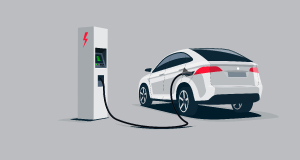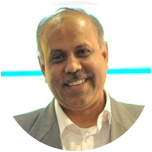You know, there's a lot of innovation happening in the electric vehicle space and I would be remiss if I didn't bring on the experts we have at Birlasoft to talk about what the future of EVs looks like. Hello and welcome to Tech lyceum. I'm Neerja and today we are talking about how electric vehicles are revolutionizing the transportation industry. Joining us are two wonderful speakers. We've got Shirish Sahay, VP and EME, a business leader for the manufacturing BBU at Birlasoft. He is a highly accomplished professional with over 30 years of experience. Now he started off as an instrumentation engineer in the manufacturing industry, eventually becoming a CIO. He later transitioned to the IT sector serving clients in manufacturing and offering strategic IT guidance to C level executives, while leading transformation programs very, very exciting, but also saying welcome back to our seasoned podcaster, who's joined us many times before Paul many senior business consultant manufacturing BVU Birlasoft. Paul serves as a senior business consultant in the manufacturing area after spending decades at Fortune 500 companies developing products and services for manufacturing, medical, defense, aerospace and transportation industries. So, let's go ahead and welcome them. Shirish Hello, and welcome to Tech lyceum.

I'm very excited Neerja. Thanks for having me today. It's really great to be a part of this podcast. I'm excited.
Absolutely. And Paul, it's good to have you back.
It's Great to be here and I actually drive in EV myself. So it'd be fun to talk about what I know in this area.
Okay, on that note, let me start with a question to you, Paul.
Q: Amid disruptive innovation and rising regulations. How do you foresee the future of the automotive industry and the role of technologies in shaping its future
Thanks Neerja. Every form of transportation is moving to cleaner forms of energy, such as renewable fuels, hydrogen, batteries and solar. And this is driving innovations in areas of weight aerodynamics, performance, construction and materials, the move to electrify the vehicle, while making sure the carbon impact is reduced, demands both scientific advances, engineering innovation and incentives for the investment. Batteries and hydrogen fuel cells will be the main sources of energy. Both are undergoing significant technological change to optimize customer satisfaction for reliability, durability, charge time, miles to charge and wait. Infrastructure to recharge batteries or refuel hydrogen tanks is being addressed by many, the battery cell design is being optimized. While battery assembly plants are being built. Battery Management Systems are being tailored to the battery and cell pack designs. The in quotes oil companies are transforming to become energy companies and the vehicle OEMs are manufacturing the battery packs themselves to lower assembly costs.Telematics is now required to optimize the use of energy to extend the miles driven and provide communications to other vehicles and the infrastructure. They allow the vehicle OEM or third parties to age drivers and fleet owners to drive better more safely and take routes that minimize delays that waste energy. Artificial intelligence software embedded in the vehicle and in the cloud is regularly updated to account for construction, accidents, weather and general improvements. The move from highly engineered internal combustion engines with hundreds or 1000s of parts is being replaced with powerful electric motors. Motor design is improving to ensure energy is not wasted. simulation software is enabling engineers to further reduce part counts, which will affect the aftermarket business models for part replacement and regular service. The future is as a service for everything from the ride itself to the battery to predictive analytics for better operation, not just parts replacement. Right through telematics the vehicle is in constant contact with the OEM to provide closed loop the feedback, enabling better designs and new business models. Ultimately, each vehicle will have its own digital twin to provide personalized recommendations to improve operation based on the unique set of options combined with the characteristics of the driver's own behavior.
How Paul Thanks for unpacking that for us, you know, things that would have seemed a distant dream way back when are now coming to life. And that's so exciting. Shirish, I'd like to ask you this.
Q: What is the role of service integrators or SIi s across the Evie value chain? And how do you think the partnership ecosystem is evolving to speed up the transformation in the automotive industry?
Thanks. That's really an interesting question. You know, what, with the technology transformations in automotive industry, what I have experienced the role of a service integrator is actually evolving. And it's evolving big time in the value chain. And all this evolution is on an accelerated conveyor belt. Increasingly, service integrators are getting involved right from the designing of evey solutions to developing the software's that run those solutions and the product engineering to drive the product innovation, driving the efficiency, and also optimizing the performance while managing the infrastructure for charging and payouts, Smart Grid integrations for power generation and distribution. So there's there's a lot which the SI is are currently getting involved in. To top it all. The most important thing is data and data collection for EVs, the data processing, and analytics is not only contributing to giving critical insights, but also contributing to the end user experience. In fact, with the strong pedigree and heritage with our group companies, which are working in powertrain precision engineering, products, bearings, etc, and our partnerships with the automotive manufacturers, the truck manufacturers, the engine manufacturers, the filtrations, etc, we have been able to leverage our knowledge and have been working on some of the critical AV programs with our customers. And it is drawing efficiency in terms of reducing operating costs, meeting compliance and quality initiatives, thereby maximizing the revenue growth, or increasing efficiency and improving product design. And again, bringing the customer experience in at the center stage. So that's the kind of areas that we are getting involved and we are seeing a lot of role for the OSI is going forward.
All right, Shirish, lots of moving parts there and lots of potential. Thank you for taking us through that. Paul, let me come back to you from a value chain perspective.
Q: How different is the traditional automotive value chain from the Evey value chain?
Thanks Neerja. As I think about it, I I see three significant differences for the Evey value chain versus the internal combustion technology. The first is the energy source and fitting it into the vehicle. Batteries involve mining of many different materials versus petroleum. A battery or hydrogen fuel cell is more complex than a metal tank with fuel in it. There are many more parts and the control of the battery is significant. While we have spent decades controlling the combustion of the petroleum in an engine, and then use more technology to clean up the exhaust. We are still in the early stages of creating the best electricity source and controlling its charging operation and cooling. The importance of this energy sources driving OEMs to make their own batteries rather than buying them from a tier one supplier. The second that comes to mind is the infrastructure for refueling the vehicle. It has taken 100 years to get to where we can reliably find a gas or diesel fuel station anytime and anywhere we needed. The development of the infrastructure for recharging the battery or refueling the hydrogen has a way to go to compete. There are incentives and momentum from energy suppliers, vehicle OEMs and nations to ensure the infrastructure is put in place quickly. One difference I see is the vehicle OEMs are going to offer that charging equipment and service, whereas they have not been part of providing fuel to internal combustion engines. Now, the third is the converter of energy to motion, the engine of the past is becoming the motor of the future, the motor is smaller, has fewer parts, and will likely require less maintenance. It does however, have a complex control system. I expect OEMs will take over motor design and manufacture in the future, just as they took over engine design and manufacturing. In the past. These differences mean the the value chain or supply chain is changing. There is a decrease in importance of the 1000s of metal machined parts for an internal combustion engine, and an increase in attention to batteries from the mining of materials through the various stages of processing and assembly to the charging infrastructure deployed and managed to the ultimate reuse, recycling or disposal. Motors have fewer parts, and as I said, are expected to require less maintenance. That's changing the business model for aftermarket parts and service to more over the air updates to enhance vehicle operation. We are already seeing existing suppliers innovating to vertically integrate to provide the batteries, motors and charging infrastructure using those incentives and regulatory mandates from governments.
All right. Thanks, Paul. For that the engine of the past is becoming the motor of the future lots we learn from the past and taken forward. And finally Shirish if I may ask you based on your customer engagements, right? Which are those Eevee specific use cases, which can be leveraged across players in the Eevee industry, specifically, the ones that are gaining maximum customer demand for rapid implementation and scale up?
That's a very interesting question. Thanks, Neerja. You know what Birlasoft has been a niche player for many of our clients, and an active contributor to our clients in developing and delivering Evie use cases for mainly environmental regulations supply chain optimization, and digital transformation. Some of the key engagements that I would like to highlight while we have done a lot, and we are continuing to do a lot, but for this particular section, I would say that, you know, for one of the largest manufacturers in Europe, we have developed a connected truck platform, and that we are supporting and delivering enhanced use cases on another one is the largest engine manufacturer that we've been working for the past two decades, for more than two decades, we've developed solutions for supply chain agility, optimization through end to end business process transformation, and most importantly, carbon emission monitoring. And another one to quote is a large battery manufacturer for buses, where Birlasoft manages the entire infrastructure and application landscape for the production and creating dashboards and reports for them. Now, in addition to that, what we have been doing is we have been actively involved with our clients in developing and delivering use cases. For Evey manufacturers like improving insights by leveraging vast amounts of transactional data to draw valuable insights, which are actionable insights. They help in boosting productivity, decrease operational cost, manage quality, and compliance processes, and in many ways contribute to the overall efficiency. Then optimizing and digitalizing supply chain and operations is another one that we are working on. Developing customer focus product design by modernizing PLM. And the manufacturing engineering systems is another one that we are currently working with some of our customers. There's yet another one that we want to highlight is fleet management, which is basically about driver monitoring vehicle telematics vehicle safety using IoT, GPS and artificial intelligence technologies and then leveraging computer vision devices to enhance that. And of course, 3d printing of auto components is another area that is contributing to the entire use case that we are currently delivering and developing for our customers. So that's what you know, is an interest same journey and the list keeps growing.
t Right fish? Well, his was great. We got some very compelling insights from both Paul and Shrish. And I'd love if both of you could share your closing thoughts as we wrap Shirish why don't you start us off.
So as I said earlier, you know, Birlasoft has been working with vehicle OEMs. And also with their tier one and tier two suppliers to build relevant use cases, and more importantly, provide the data needed to drive the improvement and the innovation. We are also helping our customers to adapt to integrated software needed to manage the transformational change. And we are not only witnessing these transformational changes, but we are actually a part of this transformation journey. That would conclude that.
And Paul
Thanks Neerja, this is an exciting time with the change from the internal combustion engine to EVs. And some of its going to go fast. Some of its going to go a little bit more slowly. But it's going to take new digital technologies in design, test, sales, marketing, manufacturing, and the aftermarket to enable this transformation. And ESRI said, None of this is possible without information at all levels, and in all areas.
Absolutely. Paul, and the information you've shared with us has been very, very useful. So thank you both for giving us the opportunity to learn a few new things and think a few new thoughts. today. It was great having you as always.
Thanks Neerja
Thank you in Neerja for having us.
Well, technology has certainly made a lot of things possible for us and the future is possible for us the future suddenly looking very eventful. There are a lot of conversations to look forward to on all the innovations that are driving businesses into a brighter tomorrow. So make sure to catch all that right here on tech lyceum. I am Neerja, signing off right now. I'll catch you next time. Bye.



